The Mauritius Kestrel, native to the paradisiacal island of Mauritius, is a testament to the indomitable spirit of nature and the power of dedicated conservation efforts.
Once hovering on the brink of extinction with only a handful of individuals remaining in the 1970s, this small raptor has defied the odds and staged a remarkable comeback.
Its story is a compelling narrative of resilience and revival, showcasing how human intervention, through intensive breeding programs and habitat restoration initiatives, can reverse the course of extinction.
In this exploration, we delve into the captivating world of the Mauritius Kestrel, unraveling its unique characteristics and the extraordinary journey that saved it from the precipice of oblivion.
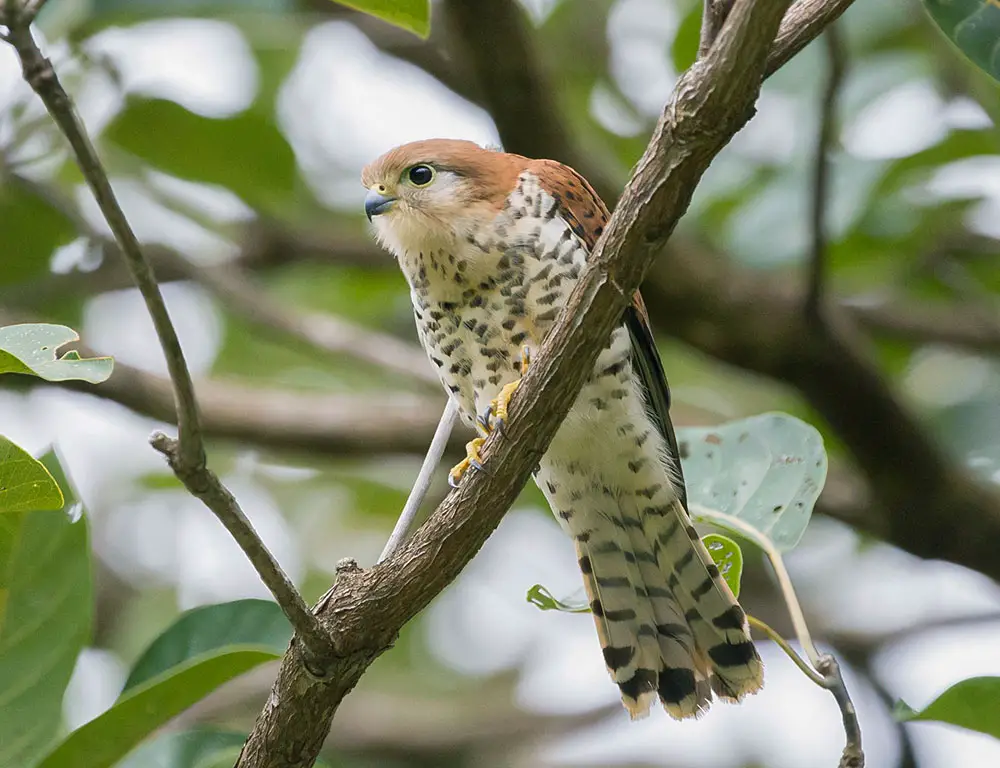
Habitat and Distribution of Mauritius Kestrel
The Mauritius Kestrel (Falco punctatus) is a small falcon endemic to the island of Mauritius in the Indian Ocean. Historical factors and ongoing conservation efforts have significantly influenced its habitat and distribution.
Here’s a detailed overview:
Habitat
- Forest Habitat: Historically, the Mauritius Kestrel inhabited various forested habitats across Mauritius, including upland forests, woodlands, and coastal regions.
It prefers areas with dense vegetation and mature trees, which provide nesting sites, perches for hunting, and a diverse array of prey species. - Preferential Canopy Cover: The kestrel often occupies habitats with a canopy cover that offers protection from direct sunlight and provides suitable roosting and nesting sites.
It favors areas where the trees form a dense canopy, creating a relatively calm and shaded environment. - Secondary Habitat: In addition to primary forest habitats, Mauritius Kestrels may also occur in secondary habitats, including regenerating forests, degraded woodlands, and areas with fragmented vegetation.
While these habitats may be less optimal, they can still support kestrel populations, especially if suitable prey species are available.
Distribution
- Historical Range: Historically, Mauritius Kestrels were distributed throughout the island of Mauritius, inhabiting various forested and woodland habitats.
However, by the mid-20th century, the species faced severe population declines due to habitat loss, introduced predators, and other human-induced factors. - Restricted Distribution: Due to population declines and habitat degradation, the distribution of Mauritius Kestrels became severely restricted.
By the 1970s, only a few individuals remained in isolated pockets of suitable habitat, primarily in Mauritius’s southwestern forests, cliffs, and ravines. - Conservation Efforts: Intensive conservation efforts, including captive breeding programs, habitat restoration initiatives, and predator control measures, have contributed to the recovery of Mauritius Kestrel populations.
Reintroduction efforts have successfully established kestrel populations in various parts of the island, expanding their distribution beyond historical ranges. - Current Distribution: Today, Mauritius Kestrels can be found in southwestern forests, cliffs, and ravines of Mauritius, as well as in secondary habitat and remnant natural habitat across the island.
While their distribution remains localized, conservation efforts focus on protecting and expanding suitable habitats to ensure the long-term survival of this endangered species.
Physical Characteristics of Mauritius Kestrel
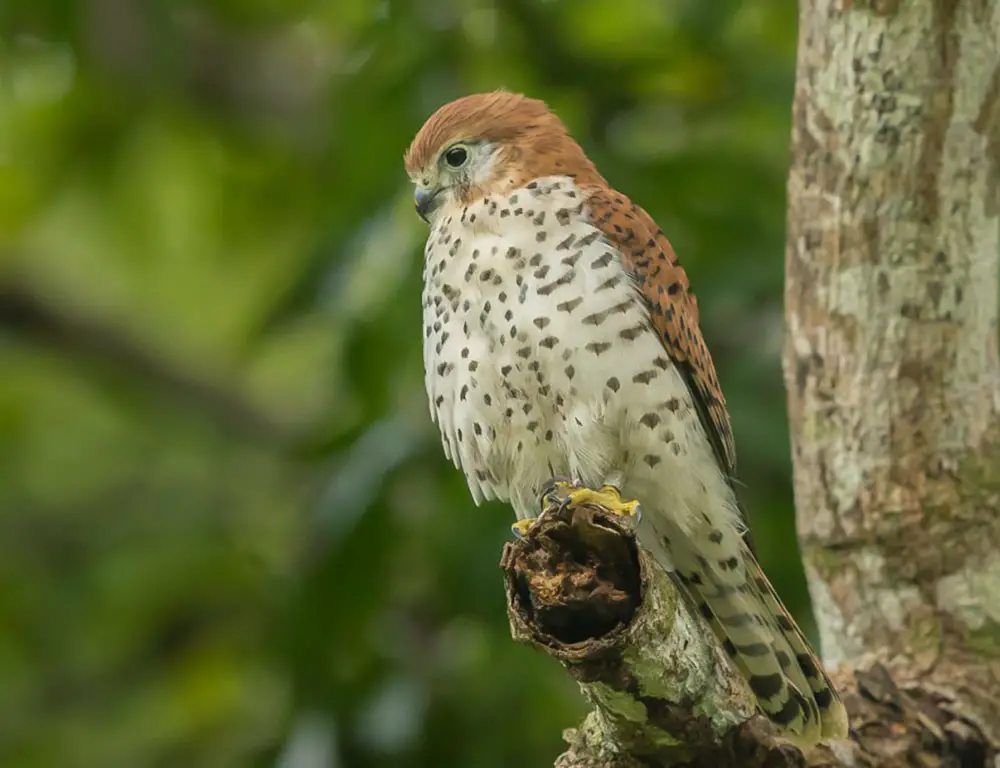
The Mauritius Kestrel (Falco punctatus) possesses distinctive physical characteristics contributing to its unique appearance and adaptive abilities.
Here’s an overview of its fundamental physical traits:
Size
The Mauritius Kestrel is relatively small, measuring 22 to 26 centimeters (8.7 to 10.2 inches). This compact size makes it one of the smaller members of the Falcon family.
Plumage
A striking combination of colors characterizes its plumage. The upper body typically exhibits a rich chestnut coloration, providing excellent camouflage in forested habitats.
In contrast, the underparts are predominantly white or cream-colored, often adorned with black streaks along the belly and flanks.
Tail
The kestrel’s tail is notable for its grey-blue coloration, with dark bands. This distinct tail pattern adds to its visual appeal and may serve aerodynamic functions during flight.
Beak and Feet
The beak and feet of the Mauritius Kestrel are adorned with vibrant yellow hues, contrasting with the earthy tones of its plumage. These features are aesthetically pleasing and serve practical purposes in hunting and feeding.
Eyes
Dark brown eyes with an intense gaze characterize the Mauritius Kestrel’s facial features. Its keen eyesight is crucial in spotting prey from a distance and executing precise hunting maneuvers.
Wing Structure
The kestrel’s wings are relatively short but broad, enabling agile flight and maneuverability in dense forest environments. This wing structure facilitates rapid acceleration and quick changes in direction during hunting flights.
Wing Patches
Hidden beneath the wings are black patches against the chestnut-colored feathers. These patches effectively camouflage, helping the bird blend into its surroundings while roosting or resting.
Diet and Feeding Habits of Mauritius Kestrel
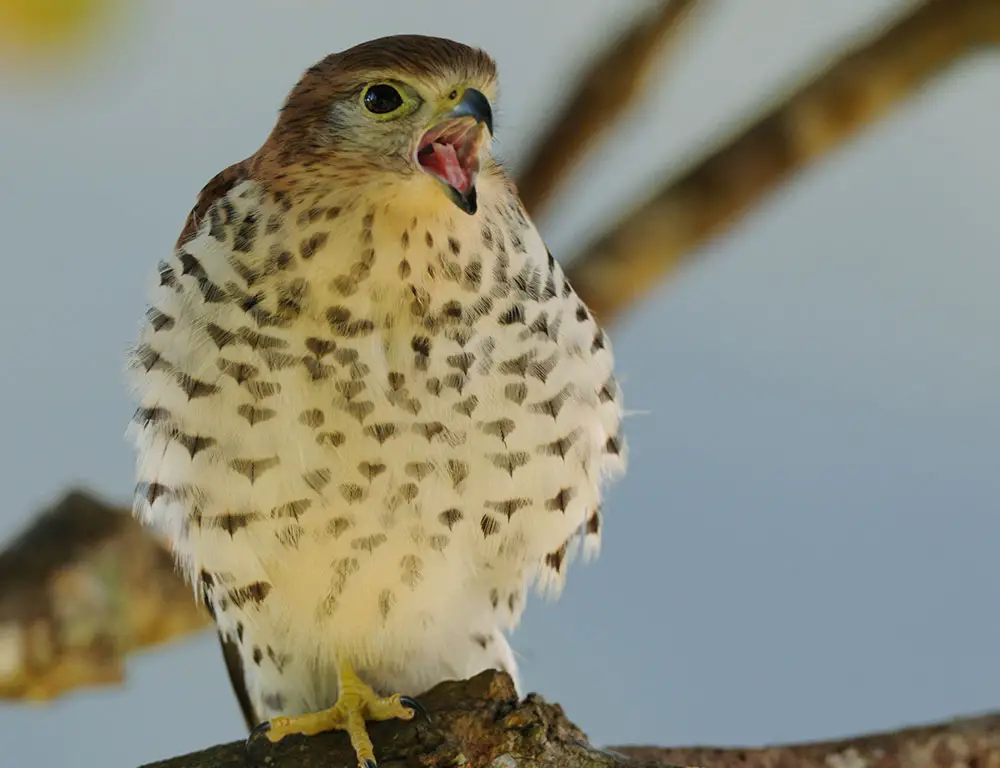
The Mauritius Kestrel (Falco punctatus) exhibits a diverse diet and distinctive feeding behaviors, reflecting its adaptation to various prey sources and hunting strategies.
Here’s a detailed overview of its diet and feeding habits:
Diet
- Small Birds: Mauritius Kestrels primarily prey on small bird species, including passerines and other avian species. They may hunt birds of various sizes, depending on availability and opportunity.
- Rodents: Another significant component of the kestrel’s diet is rodents like mice and rats. These terrestrial mammals provide a valuable food source, particularly in areas where bird prey may be scarce.
- Reptiles: Mauritius Kestrels also target geckos, skinks, and other small lizard species. These agile predators are adept at capturing reptiles on the ground and in trees.
- Insects: Insects constitute a substantial portion of the kestrel’s diet, especially during certain seasons. They may feed on insects, including beetles, grasshoppers, dragonflies, and other flying or crawling insects.
Seasonal Variation
The kestrel’s diet exhibits seasonal variation, with preferences shifting based on prey availability and ecological factors:
- Spring and Summer: During these seasons, Mauritius Kestrels consume more insects, taking advantage of the abundance of insect prey in their habitats.
- Fall: In the fall, the diet may mainly target small vertebrates, including birds and rodents.
- Winter: As winter approaches, there may be an increased focus on avian prey as migratory bird species become more abundant.
Feeding Behavior
- Solitary Hunting: Mauritius Kestrels are primarily solitary hunters, relying on their keen eyesight and swift agility to locate and capture prey. They often perch high in trees or cliffs, scanning their surroundings for movement.
- Stealthy Approach: When prey is spotted, the kestrel employs a stealthy approach, gliding precisely towards its target before launching a rapid attack. This surprise tactic helps them catch unsuspecting prey without alerting potential victims.
- Scavenging: Mauritius Kestrels may resort to scavenging for carrion in food scarcity. They are opportunistic feeders and will take advantage of any available food sources to sustain themselves, including carrion left behind by other predators.
Reproduction of Mauritius Kestrel
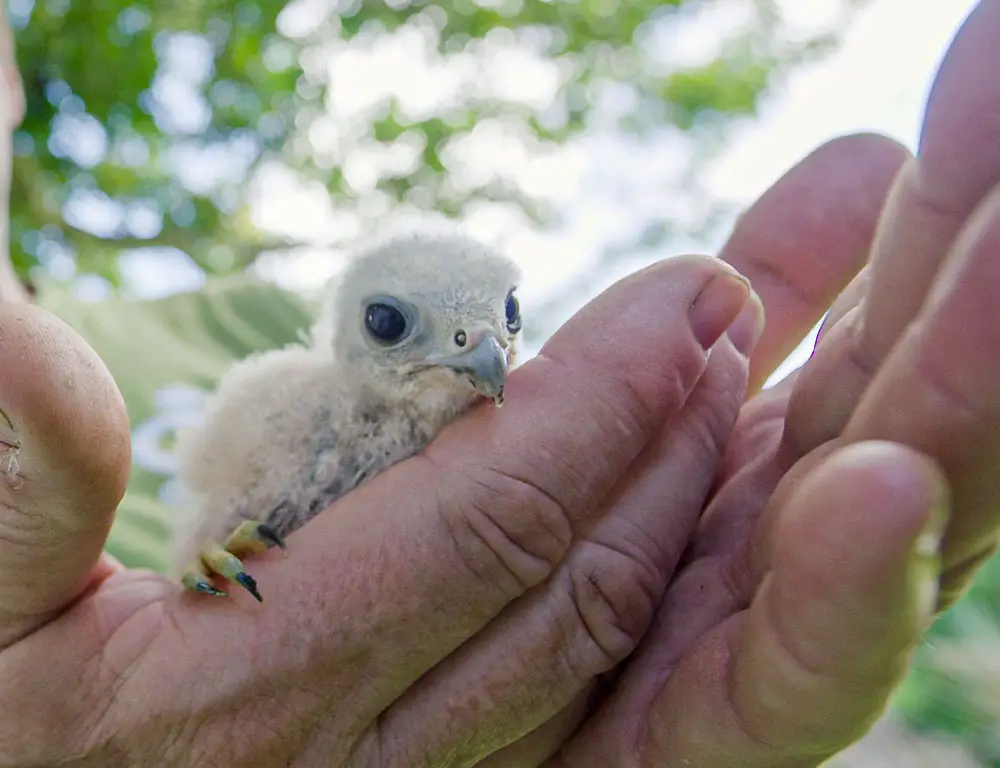
The reproduction process of the Mauritius Kestrel (Falco punctatus) is fascinating and involves several unique behaviors and adaptations.
Let’s delve deeper into the key stages of their reproductive cycle:
Mating
- Season: The mating season for Mauritius Kestrels typically spans from September to January, coinciding with favorable environmental conditions and abundant prey availability.
- Courtship Displays: Male kestrels use intricate aerial displays to attract female mates. These displays involve swooping, diving, and other acrobatic maneuvers that showcase the male’s agility and prowess as a potential mate.
- Gift-giving: In addition to aerial displays, males demonstrate their ability to provide by catching prey and presenting it to females as part of the courtship ritual. This behavior highlights the male’s hunting skills and ability to contribute to the reproductive effort.
Nesting
- Selection of Nest Sites: Mauritius Kestrels prefer nesting in high places such as cliffs or building cracks. Their nests are relatively simple, consisting of shallow scrapes on the ground or other suitable surfaces.
- Clutch Size: Females typically lay two or three eggs per clutch, which they incubate to facilitate embryo development.
- Incubation: The incubation period lasts approximately 30 days, during which the female diligently tends to the eggs, keeping them warm and protected from potential threats.
- Parental Care: Once the eggs hatch, both parents play active roles in feeding and caring for the chicks. The diet primarily consists of small lizards and insects, which are abundant in their natural habitat.
- Fledging: After 5-6 weeks post-hatch, the young kestrels are ready to leave the nest and begin exploring their surroundings. However, they continue to receive parental care and support for another month or so as they develop their hunting and survival skills.
Post-Fledging Care
After fledging, the young kestrels continue to receive parental care for approximately one month. During this time, they learn essential survival skills such as hunting, foraging, and avoiding predators under the guidance of their parents.
Conservation Status of Mauritius Kestrel
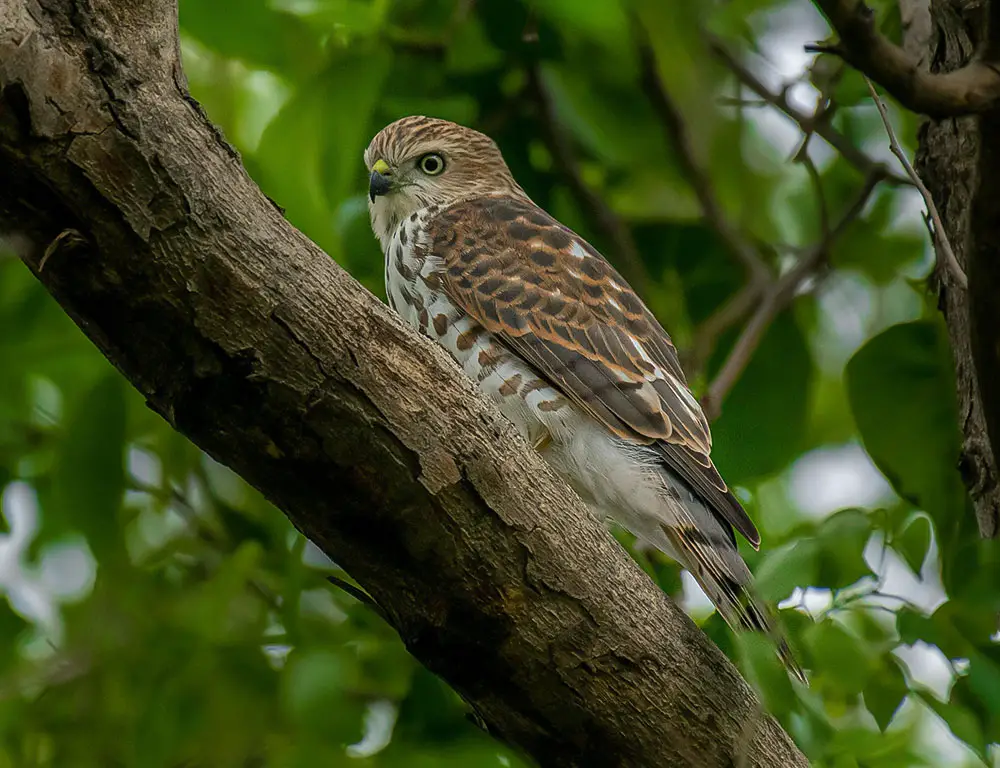
The conservation status of the Mauritius Kestrel (Falco punctatus) has seen significant improvements over the years, mainly due to dedicated conservation efforts.
Here’s an overview of its conservation status:
Current Conservation Status
- IUCN Red List: The Mauritius Kestrel is listed as “Endangered” on the International Union for Conservation of Nature (IUCN) Red List of Threatened Species. While its status has improved from previous listings as “Critically Endangered,” it still faces significant threats to its survival.
- National Protection: Within Mauritius, the Mauritius Kestrel is legally protected under national legislation. Conservation measures include habitat preservation, captive breeding and reintroduction programs, and ongoing monitoring of populations.
Conservation Successes
- Population Recovery: Conservation efforts have led to a notable increase in the Mauritius Kestrel population. The population has rebounded from a critically low number of individuals in the 1970s, with several hundred individuals now present in the wild.
- Captive Breeding Programs: Captive breeding programs, initiated in the 1970s, have played a crucial role in the recovery of the Mauritius Kestrel.
Institutions such as the Durrell Wildlife Conservation Trust and local conservation organizations have successfully bred and reintroduced kestrels into the wild, contributing to population growth. - Habitat Restoration: Efforts to restore and preserve the kestrel’s habitat have been integral to its conservation. Reforestation, habitat management, and invasive species control have helped create suitable environments for kestrels to thrive.
- Community Engagement: Local communities and conservation organizations have actively participated in kestrel conservation efforts.
Public awareness campaigns, community engagement initiatives, and education programs have raised awareness about the importance of kestrel conservation and garnered support for conservation measures.
Ongoing Challenges
- Habitat Loss and Degradation: Habitat loss and degradation remain significant threats to the Mauritius Kestrel. Urbanization, agriculture, and infrastructure development continue encroaching upon kestrel habitats, reducing available nesting and foraging areas.
- Invasive Species: Introduced predators, such as rats and mongooses, pose a significant threat to kestrel populations by preying on eggs, chicks, and adults. Control measures are ongoing to manage invasive species and mitigate their impacts on kestrel populations.
- Climate Change: The effects of climate change, including extreme weather events and habitat alteration, may exacerbate threats to kestrel populations. Adaptation strategies and monitoring efforts are needed to assess and address the impacts of climate change on the species.
Conclusion
The journey through the remarkable story of the Mauritius Kestrel has been nothing short of inspiring.
From the brink of extinction with only four individuals in 1974 to a thriving population of over 800 by 1994, their tale embodies the power of dedicated conservation efforts.
This tiny falcon’s resilience and adaptability teach us valuable lessons about hope and adaptation in the face of adversity.
As we reflect on its incredible journey, we’re reminded of the critical importance of preserving biodiversity and the role each of us plays in safeguarding our planet’s precious wildlife.
Let the Mauritius Kestrel’s story serve as a beacon of hope, inspiring us all to take action and support conservation initiatives, for every contribution, no matter how small, makes a meaningful difference in protecting our natural world.